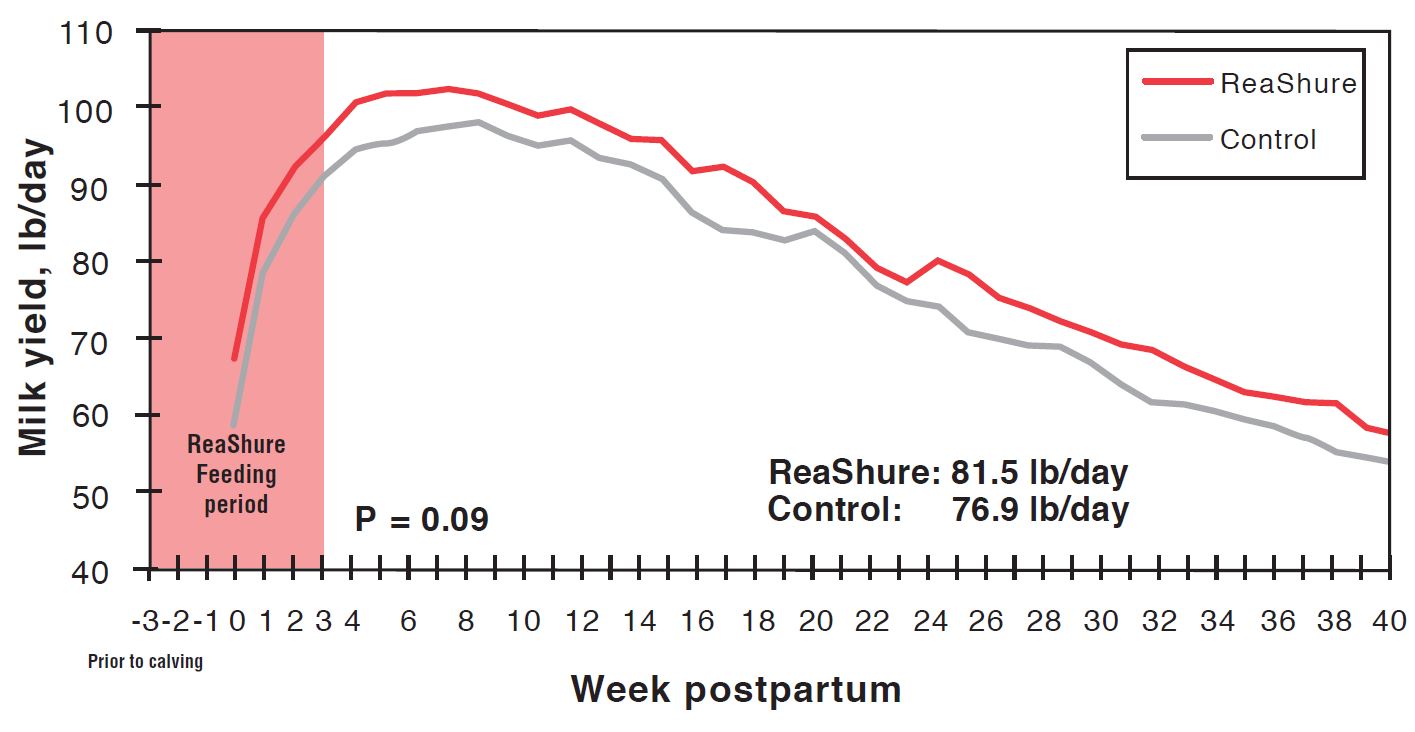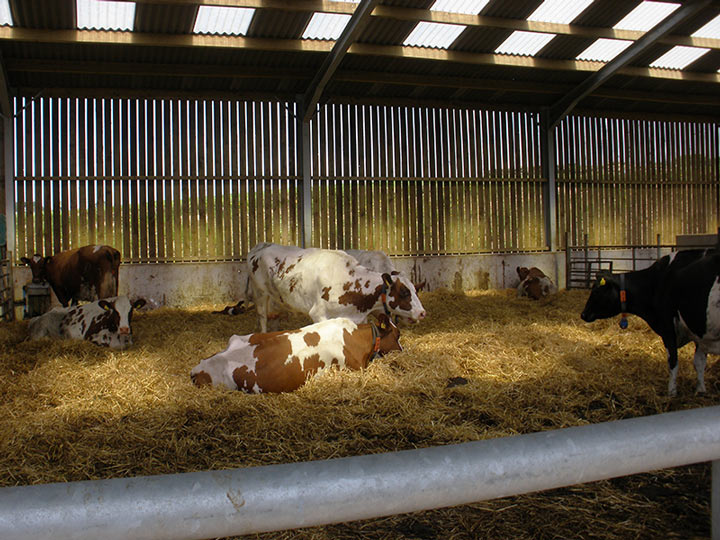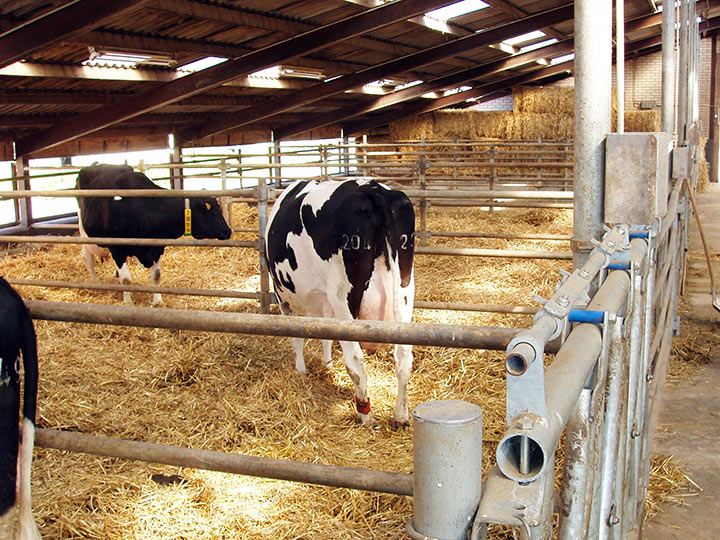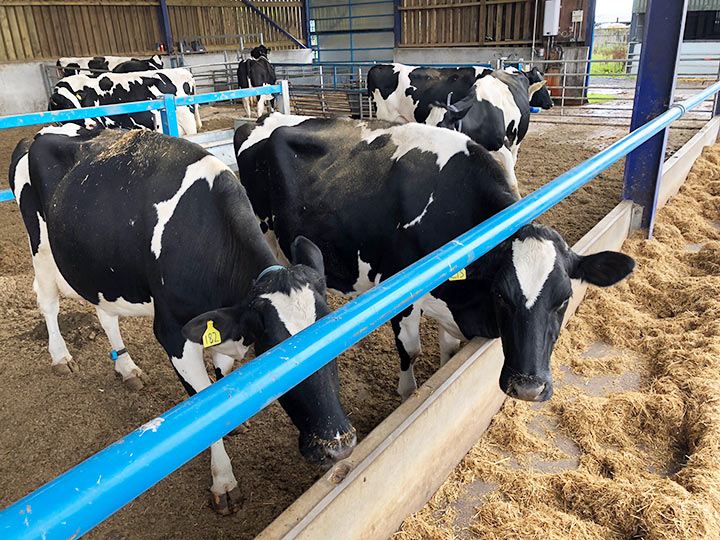
Around the time of calving, cows mobilise stores of body fat (NEFA) to supply the energy required to maximise milk production. NEFA is packaged in the liver with choline so that it can be transported to the mammary gland to make milk and butterfat. If choline is in short supply the NEFA cannot be transported out of the liver and is stored there, causing fatty liver and ketosis. Providing adequate levels of choline to transition cows can help reduce metabolic disease and increase milk production.
ReaShure®-XC Precision Release Choline helps meet the cow's requirement for choline by protecting it from rumen degradation. ReaShure®-XC can be fed in many ways: mixed into the grain/TMR or top-dressed using our convenient measuring cup. For best results we recommend feeding 30 gms of ReaShure®-XC per head per day for 21 days before calving to 21 days after calving. Unfortunately not all grouping systems can accommodate this feeding regime.
Extensive studies show ReaShure®-XC reduces instances of clinical ketosis, metritis, retained placenta, displaced abomasums, mastitis and death.
Studies have shown that feeding ReaShure®-XC in the transition period increases milk yields by an average of approx. 670 Kilos of milk per year.
ReaShure®-XC-fed cows produce significantly more Immunoglobulin G per litre of colostrum (68.2 vs 86.9g/L)!
In trials, pregnancies from first service in cows fed ReaShure®-XC were higher (41.3% vs 23.6%).
In Utero exposure to ReaShure®-XC yields an increased growth rate in calves.
Choline is an essential nutrient that allows cows to utilize the fat (NEFA) mobilised from body stores. That production of NEFA is the cows' natural way of managing negative energy balance during the early stages of lactation and is a primary source of energy for many functions. A healthy and properly functioning liver allows cows to transition smoothly, resulting in elevated peak milk and a much more persistent lactation curve for maximum productivity. Issues occur when the cow's liver cannot effectively process all the NEFA being mobilised. This can adversely affect liver function by leading to increased ketones in the blood (ketosis). Ketosis can negatively affect feed intake and further exacerbate negative energy balance, leading to even more NEFA mobilisation.
A recent study carried out at the University of Florida evaluated the impact of feeding ReaShure® Precision Release Choline to cows during the transition period on milk production over the entire lactation. The study also tracked cow health, reproduction, calf performance and colostrum quality.
Cows fed ReaShure® during the transition period produced an average of 4.6 lbs more milk per day (P = 0.09) over the first 40-weeks postpartum (see chart). This calculates to an additional 1,288 lbs during the first 40 weeks of lactation. If we extrapolate these results over a 305-day lactation, the outcome would be an additional 1,403 lbs of milk per cow per year. Percent fat and protein were not statistically impacted for the ReaShure®-fed cows. But both fat, 3.43 vs. 3.61 lbs/day (P = 0.09) and protein, 2.66 vs. 2.79 lbs/day (P = 0.07) yield increased as a result of the increased milk production seen in the ReaShure®-fed cows. It is also of interest to note that cows (n = 76) considered to have non-excessive body condition at calving (BCS ≤ 3.5) produced on average 6.0 lbs more milk per day (P = 0.09) when fed ReaShure®. This simply shows that cows of normal body condition respond quite well to ReaShure®.

Effect of Feeding ReaShure® During Transition on Milk Production Over 40 Weeks
Colostrum volumes were statistically the same (19.1 vs. 20.7 pounds for the control and ReaShure® fed cows, respectively). However, the ReaShure® fed cows produced significantly (P = 0.03) more Immunoglobulin G per litre of colostrum (68.2 vs. 86.9 g/L, Figure 2). This could have practical implications for calf health.
Effect of Feeding ReaShure® Prepartum on Colostrum Quantity and Quality
Over a huge sample of animals (over 150'000 and counting) involved in the ReaShure® Real Results Challenge, a positive impact can been seen for a wide range of issues after using ReaShure®.
Feeding ReaShure®-XC to close-up cows and fresh-calvers has a more beneficial effect than only feeding to maternity and infirmary groups, however a positive effect can be seen regardless of groupings.
For herds that do not have a close-up group or a fresh cow group this is a good option.
Most dairy farmers keep cows in the maternity pen a few days prior to and after calving. Moving the cows in just a little earlier can lead to significant improvements in cow performance and health. To ensure an adequate level of choline during the large spike in blood NEFA levels (see chart), we recommend keeping your cows in the maternity pen at least four days before calving and for a minimum of four days after calving.
Feed 40 grams of ReaShure®-XC per head per day for a minimum of four days prior to calving and continue until four days after calving.

For herds have a close-up group but do not have a group for fresh cows this option is recommended.
Feeding ReaShure®-XC to the close-up group is very important to make sure the cow has plenty of choline circulating in her system well before the surge in NEFA begins.
Feed 30 grams of ReaShure®-XC per head per day starting 21 days prior to calving and in the maternity and infirmary groups.

For herds have both a close-up group and a fresh cow group this option is recommended.
Feeding ReaShure®-XC during the entire transition period is the best option for making sure that your transition cows have the choline they require to reduce metabolic disorders and to maximise milk production.
Feed 30 grams of ReaShure®-XC per head per day starting 21 days prior to calving and continue feeding ReaShure®-XC until 21 days after calving.

Find us on Social Media!
Are you using social media? Reach out to us, read updates related to Ruminant Nutrition and the Dairy & Beef Industry as a whole. Lakeland Scottish Feeds & Services are constantly striving to innovate and develop new technologies and products aimed at helping farmers unleash the full potential of their herd!
Get in touch!
Facebook
Find us on
Twitter